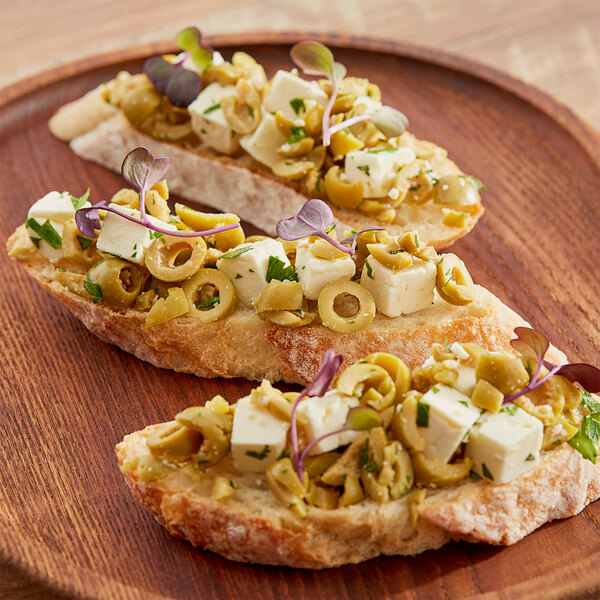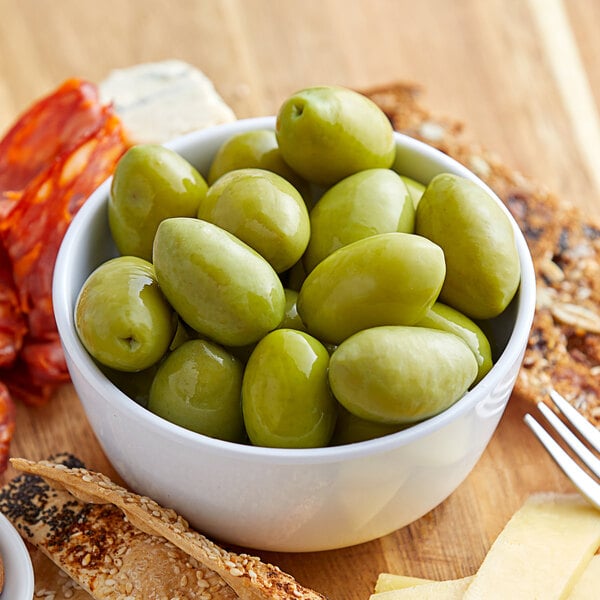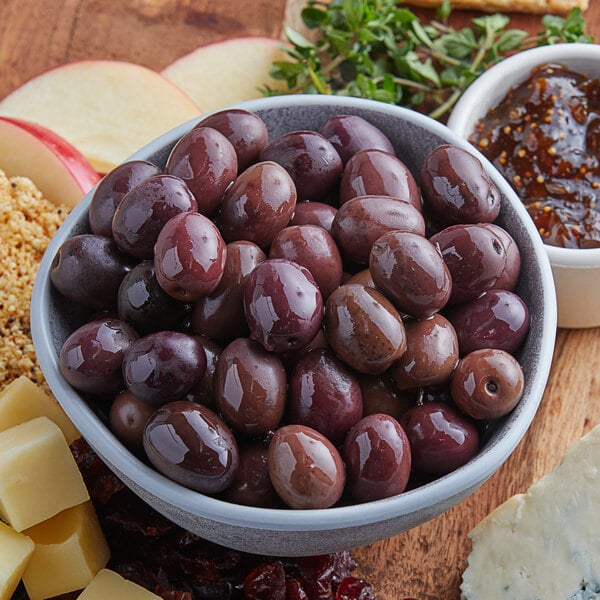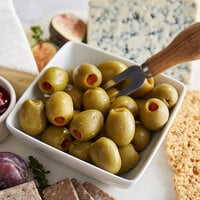To choose the right type of olives for your application, consider factors such as flavor, texture, and intended use. Some olives are known for their mild, buttery flavor, while others have a robust and tangy taste. Their textures vary from firm and meaty to soft and tender. We provide a list of the 10 most popular olives, the unique characteristics of each type, and their recommended uses and flavor profiles.
1. Kalamata Olives

Originating from Greece, Kalamata olives are an essential ingredient in Mediterranean cuisine and are commonly used in dishes such as Greek salads, moussaka, and pastitsio. They are typically large and almond-shaped, have a deep purple-to-black color, and smooth, shiny skin. Their flesh is meaty and firm.
Kalamata olives have a complex flavor that combines elements of sweetness, saltiness, and tanginess. They are beloved for their robust, fruity flavor that has hints of wine and vinegar. The olives are usually preserved in a brine solution, which enhances their flavor and helps to extend their shelf life.
- Origin: Greece
- Also Called: Calamata, Kalamon, Calamon
- Curing Method: Water or brine
- Characteristics: Cured black. Dark purple skin. Medium size and soft texture. Rich, meaty flavor.
- Applications: Olive oil, salads, pizzas, tapenade
2. Castelvetrano Olives

Castelvetrano olives are a popular variety of olive that originates from the town of Castelvetrano in Sicily, Italy. They are often referred to as Nocellara del Belice olives, in homage to the region where they are grown.
Castelvetrano olives offer a mild, buttery flavor profile with hints of sweetness and nuttiness.
Thanks to their early harvest while they're still young and ripening, Castelvetrano olives have a bright green hue. The olives are cured in a brine solution, which helps to preserve their natural color and enhances their flavor. Their comparatively mild flavor and meaty texture add a subtle and satisfying complement to poultry and fish dishes.
- Origin: Castelvetrano, Italy
- Also Called: Nocellara del Belice
- Curing Method: Brine or lye
- Characteristics: Cured green. Large size, tender skin, and firm bite. Mild, nutty, buttery flavor that is favored by those with sensitive palates.
- Applications: Chicken dishes, fish dishes, tapas, charcuterie
3. Nicoise Olives

Nicoise olives, also known as olives de Nice, originate from the Nice region of France. They're small in size and have a firm texture. They are typically harvested when they are fully ripe, giving them a rich and intense flavor that is slightly bitter, distinctly earthy, and nutty with a hint of sweetness.
Because they are left on the tree for an extended period to ripen fully, Nicoise olives boast a dark purple to black color. They're common in Mediterranean cuisine, particularly in dishes from the Provence region of France. They are a staple ingredient in the classic French salad, Salade Nicoise.
- Origin: France
- Also Called: Cailletier, Cayet, Taggiasca
- Curing Method: Brine
- Characteristics: Cured black. Small in size. Intensely sour, briny, pleasantly bitter flavor.
- Applications: Salade Nicoise, paired with sheep and goat cheeses, mild and sweet olive oil
4. Manzanilla Olives

Manzanilla olives, also known as Manzanilla de Sevilla, are a popular variety of olives that originate from Spain. These olives are small to medium in size and have a distinct oval shape. They are often harvested when they are still green, giving them a vibrant and attractive appearance. However, they're also used to make canned black olives. Green Manzanilla olives are turned black through oxidation in the curing process.
Manzanilla olives have a slightly bitter taste balanced by a pleasant and tangy flavor. They are commonly used in paella and tapas in Spanish cuisine. They are also a popular choice for garnishing cocktails such as a classic martini or a Bloody Mary.
- Origin: Spain
- Also Called: Manzanillo, Spanish Olive
- Curing Method: Brine or lye
- Characteristics: Often cured green. Varied in size. Plump, firm texture. Briny, slightly bitter flavor.
- Applications: Pitted and stuffed, martinis, tapas, paella
5. Cerignola Olives

Cerignola olives, also known as Bella di Cerignola olives, are a popular variety that originates from the Puglia region in Southern Italy. They're named after the town of Cerignola, where they have been cultivated for centuries. They are some of the largest olives available in the market, with an average size of about 2-3 centimeters in diameter. Their plump and meaty texture makes them a favorite among olive enthusiasts.
Cerignola olives have a mild and buttery flavor profile, with a hint of sweetness. They are typically harvested at the beginning of the ripening stage when they are still green. This gives them their vibrant green color and firm texture. As they mature, the olives turn a purplish-black color and develop a richer, more intense flavor.
- Origin: Italy
- Also Called: Bella di Cerignola
- Curing Method: Lye
- Characteristics: Cured green, red, and black. Large size. Mild, sweet, buttery flavor. Immature green olives have a firm texture; mature black olives are softer.
- Applications: Stuffed olives, salads, pasta dishes, fish dishes, chicken entrees
6. Gaeta Olives

Gaeta olives originated in the small town of Gaeta, Italy. They have a complex and robust flavor profile with notes of bitterness and saltiness. They're typically small to medium in size and have a firm, meaty texture with slightly wrinkled skin. However, look for plump and shiny Gaeta olives and avoid olives that appear shriveled or dull, because that can indicate poor quality.
Gaeta olives are traditionally cured in a brine solution, which helps to enhance their flavor and preserve their texture. They are commonly used in Mediterranean and Italian cuisine, adding a burst of flavor to salads, pasta dishes, pizzas, and antipasto platters. The intense flavor of Gaeta olives pairs well with other bold ingredients such as garlic, anchovies, and capers.
- Origin: Italy
- Also Called: Gyeta, Itrana
- Curing Method: Salt or brine
- Characteristics: Cured black. Dark purple skin. Small size. Soft texture. Tart, salty flavor.
- Applications: Puttanesca sauce, tapenade, Kalamata olive substitute
7. Picholine Olives

Picholine olives are native to the Mediterranean region where they have been cultivated for centuries. They are typically small to medium in size and have a slightly curved, oblong shape. This unique shape makes them easy to identify and adds an elegant touch to any dish or enhances a trendy charcuterie cone.
Picholine olives have a distinct flavor profile that is both tangy and slightly salty with a subtle fruity undertone, adding a pleasant complexity to their flavor. They are known for their crisp texture and firm flesh, making them ideal for snacking or adding to salads, pasta dishes, or tapenades.
- Origin: France
- Also Called: Colliasse, Fausse Lucques, Piquette
- Curing Method: Brine or lye
- Characteristics: Cured green. Small size, characteristic torpedo shape. Frim, crisp texture. Lemony, briny, buttery flavor.
- Applications: Moroccan olive oil, fish dishes, martinis, charcuterie boards
8. Queen Olives

Queen olives are known for their large size and rich flavor. They're typically harvested when fully ripe, resulting in a sweet and buttery flavor. Since they're larger than other varieties, queen olives are a visually appealing choice for garnishing martinis or serving as a standalone snack. Their size also means that they have a higher flesh-to-pit ratio, making them easier to work with in culinary applications.
Queen olives are commonly used in Mediterranean and Middle Eastern cuisines, where they are a staple ingredient in dishes like tapenades, antipasto platters, and mezze spreads. They can also be stuffed with a variety of fillings, such as cheese, garlic, or peppers, to add an extra layer of flavor.
- Origin: Spain
- Also Called: Sevillano, Gordal
- Curing Method: Lye, brine, or water
- Characteristics: Cured green. Large size. Firm, meaty texture. Briny, nutty flavor.
- Applications: Martini olives, stuffing olive, mezze spreads, tapenades
9. Mission Olives

Mission olives, also known as California black olives, are known for their rich, meaty texture and mild, bright, and grassy flavor. They have a shiny, black skin that adds a visually appealing element to any dish. This color is achieved through a natural curing process that involves brining the olives in a saltwater solution.
Mission olives are typically harvested when they are fully ripe, which gives them their distinct flavor profile. They are typically larger than other varieties, making them great for stuffing or enjoying on their own. They are the most popular type of olive in the United States and are frequently used as a topping on different varieties of pizza.
- Origin: California, United States
- Also Called: California Mission
- Curing Method: Lye, brine, or salt
- Characteristics: Cured black. Small in size. Mild yet peppery flavor.
- Applications: Pizzas, sandwiches, salads, and olive oil
10. Calabrese Olives

Calabrese olives, also known as Calabrian olives, come from the Calabria region in Southern Italy. Their slightly bitter and tangy flavor profile is accented by hints of fruitiness and spiciness. Calabrese olives add depth and complexity to a variety of Italian dishes and are often included in antipasto platters, salads, pasta dishes, and pizza toppings.
Calabrese olives are typically small- to medium-sized and have an oval shape. They have a firm texture and a deep, dark purple color when fully ripened. The olives are harvested at the peak of their flavor and then cured to enhance their taste and texture and remove their natural bitterness.
- Origin: Calabrian region, Southern Italy
- Also Called: Oliva Schiacciate, Calabria
- Curing Method: Brine
- Characteristics: Deep purple to black color. Firm, meaty texture. Slightly bitter flavor balanced by pleasant fruit and nut undertones.
- Applications: Antipasto platters, salads, pasta dishes, and pizzas




















